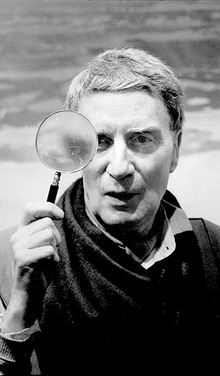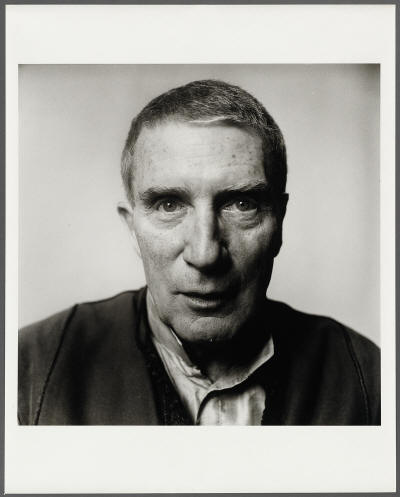 Brion Gysin (19 January 1916 – 13 July 1986) was a painter, writer, sound
poet, and performance artist born in Taplow, Buckinghamshire.[1]
Brion Gysin (19 January 1916 – 13 July 1986) was a painter, writer, sound
poet, and performance artist born in Taplow, Buckinghamshire.[1]
Queer Places:
Downside School, Stratton-on-the-Fosse, Radstock BA3 4RJ, Regno Unito
Sorbonne, Sorbona, Parigi, Francia
 Brion Gysin (19 January 1916 – 13 July 1986) was a painter, writer, sound
poet, and performance artist born in Taplow, Buckinghamshire.[1]
Brion Gysin (19 January 1916 – 13 July 1986) was a painter, writer, sound
poet, and performance artist born in Taplow, Buckinghamshire.[1]
He is best known for his discovery of the cut-up technique, used by his friend, the novelist William S. Burroughs. With the engineer Ian Sommerville he invented the Dreamachine, a flicker device designed as an art object to be viewed with the eyes closed. It was in painting and drawing, however, that Gysin devoted his greatest efforts, creating calligraphic works inspired by the cursive Japanese "grass" script and Arabic script. Burroughs later stated that "Brion Gysin was the only man I ever respected."[2]
John Clifford Brian Gysin was born at the Canadian military hospital in the grounds of Cliveden, Taplow, England. His mother, Stella Margaret Martin, was a Canadian from Deseronto, Ontario. His father, Leonard Gysin, a captain with the Canadian Expeditionary Force, was killed in action eight months after his son's birth. Stella returned to Canada and settled in Edmonton, Alberta where her son became "the only Catholic day-boy at an Anglican boarding school".[3] Graduating at fifteen, Gysin was sent to Downside School in Stratton-on-the-Fosse, near Bath, Somerset in England, a prestigious college run by the Benedictines and known as "the Eton of Catholic public schools". Despite, or because of, attending a Catholic school, Gysin became an atheist.[4]
In 1934, he moved to Paris to study La Civilisation Française, an open course given at the Sorbonne where he made literary and artistic contacts through Marie Berthe Aurenche, Max Ernst's second wife.[5] He joined the Surrealist Group and began frequenting Valentine Hugo, Leonor Fini, Salvador Dalí, Picasso and Dora Maar. A year later, he had his first exhibition at the Galerie Quatre Chemins in Paris with Ernst, Picasso, Hans Arp, Hans Bellmer, Victor Brauner, Giorgio de Chirico, Dalí, Marcel Duchamp, René Magritte, Man Ray and Yves Tanguy. On the day of the preview, however, he was expelled from the Surrealist Group by André Breton, who ordered the poet Paul Éluard to take down his pictures. Gysin was 19 years old. His biographer, John Geiger, suggests the arbitrary expulsion "had the effect of a curse. Years later, he blamed other failures on the Breton incident. It gave rise to conspiracy theories about the powerful interests who seek control of the art world. He gave various explanations for the expulsion, the more elaborate involving 'insubordination' or lèse majesté towards Breton".[5]

Verso: stamp, "The Estate of Peter Hujar, Stephen Koch Executor, Printed by the Artist"; stamp, "Copyright 1987, The Estate of Peter Hujar, Not to be Reproduced Without Written Permission from the Estate"; stamp, "From the Estate #" in pencil, "882-3-10"; signed in pencil, "Stephen Koch"; in pencil, "EPH 301-1"; in pencil, "Bryon Gysin, 1980"; in pencil, "HUJ 190".
After serving in the U.S. army during World War II, Gysin published a biography of Josiah "Uncle Tom" Henson titled, To Master, a Long Goodnight: The History of Slavery in Canada (1946). A gifted draughtsman, he took an 18-month course learning the Japanese language (including calligraphy) that would greatly influence his artwork. In 1949, he was among the first Fulbright Fellows. His goal: to research the history of slavery at the University of Bordeaux and in the Archivo de Indias in Seville, Spain, a project that he later abandoned. He moved to Tangier, Morocco after visiting the city with novelist and composer Paul Bowles in 1950. In 1952/3 he met the travel writer and sexual adventurer Anne Cumming and they remained friends until his death.[6]
In 1954 in Tangier, Gysin opened a restaurant called The 1001 Nights, with his friend Mohamed Hamri, who was the cook. Gysin hired the Master Musicians of Jajouka from the village of Jajouka to perform alongside entertainment that included acrobats, a dancing boy and fire eaters.[7][8] The musicians performed there for an international clientele that included William S. Burroughs. Gysin lost the business in 1958,[9] and the restaurant closed permanently. That same year, Gysin returned to Paris, taking lodgings in a flophouse located at 9 rue Gît-le-Coeur that would become famous as the Beat Hotel.
When Burroughs returned from London in September 1959, Gysin not only shared his discovery with his friend but the new techniques he had developed for it. Burroughs then put the techniques to use while completing Naked Lunch and the experiment dramatically changed the landscape of American literature. Gysin helped Burroughs with the editing of several of his novels including Interzone, and wrote a script for a film version of Naked Lunch, which was never produced. The pair collaborated on a large manuscript for Grove Press titled The Third Mind but it was determined that it would be impractical to publish it as originally envisioned. The book later published under that title incorporates little of this material. Interviewed for The Guardian in 1997, Burroughs explained that Gysin was "the only man that I've ever respected in my life. I've admired people, I've liked them, but he's the only man I've ever respected." [11] In 1969, Gysin completed his finest novel, The Process, a work judged by critic Robert Palmer as "a classic of 20th century modernism".[12]
A consummate innovator, Gysin altered the cut-up technique to produce what he called permutation poems in which a single phrase was repeated several times with the words rearranged in a different order with each reiteration. An example of this is "I don't dig work, man/Man, work I don't dig." Many of these permutations were derived using a random sequence generator in an early computer program written by Ian Sommerville. Commissioned by the BBC in 1960 to produce material for broadcast, Gysin's results included "Pistol Poem", which was created by recording a gun firing at different distances and then splicing the sounds. That year, the piece was subsequently used as a theme for the Paris performance of Le Domaine Poetique, a showcase for experimental works by people like Gysin, François Dufrêne, Bernard Heidsieck, and Henri Chopin.
With Sommerville, he built the Dreamachine in 1961. Described as "the first art object to be seen with the eyes closed",[13] the flicker device uses alpha waves in the 8-16 Hz range to produce a change of consciousness in receptive viewers.
In 1985 Gysin was made an American Commander of the French Ordre des Arts et des Lettres. He'd begun to work extensively with noted jazz soprano saxophonist Steve Lacy. They recorded an album in 1986 with French musician Ramuntcho Matta, featuring Gysin singing/rapping his own texts, with performances by Lacy, Don Cherry, Elli Medeiros, Lizzy Mercier Descloux and more. The album was reissued on CD in 1993 by Crammed Discs, under the title Self-Portrait Jumping.
On July 13, 1986 Brion Gysin died of lung cancer. Anne Cumming arranged his funeral and for his ashes to be scattered at the Caves of Hercules in Morocco.[14] An obituary by Robert Palmer published in The New York Times described him as a man who "threw off the sort of ideas that ordinary artists would parlay into a lifetime career, great clumps of ideas, as casually as a locomotive throws off sparks".[15] Later that year a heavily edited version of his novel, The Last Museum, was published posthumously by Faber & Faber (London) and by Grove Press (New York).
As a joke, Gysin had contributed a recipe for marijuana fudge to a cookbook by Alice B. Toklas; it was unintentionally included for publication, becoming famous under the name Alice B. Toklas brownies.[16]
My published books: